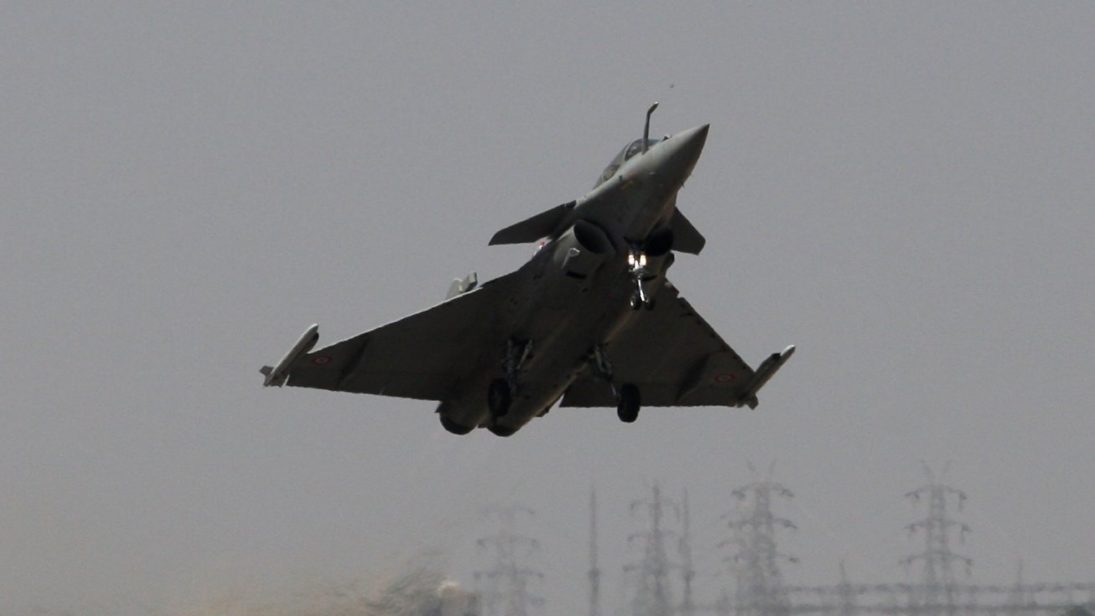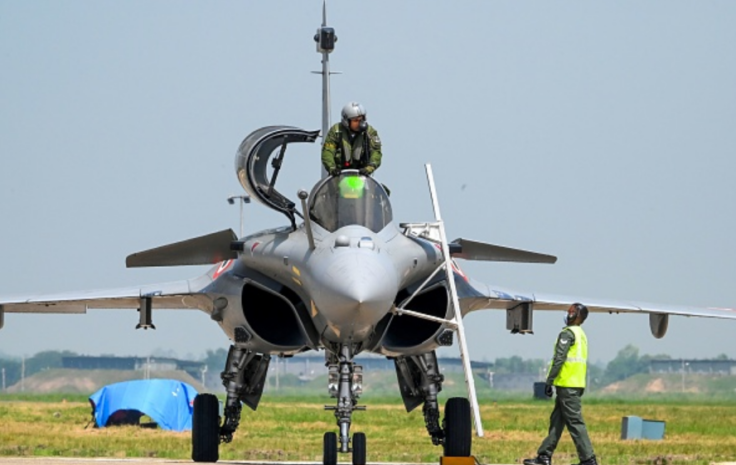
On September 10, 2020 the first batch of five Rafale fighter aircrafts were formally inducted into the Indian Air Force (IAF) in the presence of French and Indian Defence Ministers at Ambala Air Base. The remaining 31 Rafale are anticipated to arrive by December 2021. At the induction ceremony, IAF Chief RKS Bhadauria noted that the jets could not have arrived “at a more opportune time.” Referred to as a “game changer” by Indian Defense Minister Rajnath Singh, the question remains: what type of a capability will the Rafale provide the IAF? As India becomes increasingly wary of the Pakistan-China nexus, the eventual induction of 36 Rafale aircraft will be instrumental in sharpening India’s conventional deterrence in the region.
Addressing Gaps in the IAF
In the aftermath of losing an IAF warplane during the aerial dogfight with the Pakistan Air Force (PAF) after the IAF’s Balakot Strikes, India expressed regret for not having a more technologically advanced fighter like the Rafale, with Prime Minister Narendra Modi stating that if India had the Rafale then no IAF warplane would have been lost on February 27, 2019. Modi’s statement reflected a number of gaps in the IAF which the Rafale is meant to fill. As a new and more technologically advanced aircraft, the Rafale helps modernize India’s ageing fleet. For instance, the Rafale is the only European combat aircraft employing Active Electronically Scanned Array (AESA) radar, a technology the IAF also demands for the upcoming 83 indigenous LCA Tejas Mk1A. AESA radar, when compared to mechanical radars, makes the fighter jet more able to detect threats early and track targets. The Rafale is also capable of jamming electronic warfare as well as performing air-to-air and air-to-ground attacks with missiles including the long-range Meteor and SCALP missiles, as well as MICA and HAMMER missiles. The Meteor missile is particularly noteworthy as a beyond-visual range air-to-air missile—a technology the IAF reportedly lacked during Balakot.
The Meteor missile is particularly noteworthy as a beyond-visual range air-to-air missile—a technology the IAF reportedly lacked during Balakot.
One of the most important components of the Rafale deal is the performance logistics component with France committing to maintaining a state of operational readiness (availability rate) for 75 percent of the 36 IAF Rafale aircrafts. The availability rate refers to the number of aircraft available at any given point in time for a combat flight. Currently, the IAF has mostly Russian fighter aircrafts, which have often had lower availability rates. In 2018, for instance the availability rate for example of the Sukhoi-30MKI, one of the main fighters in the IAF, was only 50 percent.
Acquiring the Rafale
The origins of the Rafale deal begin in 2000, with the IAF expressing an interest in acquiring 126 French Mirage 2000 jets—the predecessor to the Rafale—produced by Dassault Aviation. The IAF had a preference for the Mirage 2000 because of the capabilities of the aircraft, including laser-guided bombs, which played a vital role in India’s performance in the Kargil war. However, after the Government of India rejected the deal, the IAF instead refocused on adding Medium Multirole Combat Aircraft (MMRCA), which meant additional companies placed bids for a procurement deal. Dassault was narrowed down as the top bid in the process, and had begun producing the Rafale rather than the Mirage 2000. In 2012, India and France signed a deal for 126 aircraft—18 fly-away and 108 to be built by Hindustan Aeronautics Limited (HAL), and signed a workshare agreement in 2014.
In 2015, the Rafale made headlines again as Modi announced during his visit to France that to enhance the IAF’s capabilities, India would purchase 36 fly-away Rafale. The idea of purchasing a smaller number of 36 Rafale in place of original 126 Rafale may have been based on ensuring faster operational readiness of the IAF. The 36 Rafale were ordered as “ready to fly” addressing the time commitment required for constructing the aircraft. While the Modi administration drew criticism for the cost of the new deal and changing the offset partner from HAL to Reliance Defence, reports also emerged that the original Dassault-HAL partnership had begun to fall through and the Supreme Court ultimately dismissed petitions to investigate the deal.
The Rafale deal was signed in September 2016 in form of an Inter-Governmental Agreement and on July 29, 2020 the first five Rafale arrived from France to India at Ambala Air Base. Since July 29 the squadron comprising Rafale, called the Golden Arrows, has been flying and gaining familiarity with operations—including firing advanced weaponry—with in-depth integrated training with other IAF fighter aircrafts. The Golden Arrows is located at India’s oldest air base in Ambala, which was built in 1919. The squadron had been vital during the high-altitude conflict in the Kargil War, where it flew MiG-21 fighter aircrafts which were located in Bhatinda Air Base.

The Rafale Fighter and India’s Current Threat Perceptions
India currently is concerned with threats from two potential adversaries: Pakistan and China. With respect to Pakistan, the Rafale may deter the PAF in some parameters. One of the lessons from Balakot is the potential for India-Pakistan conflicts to escalate to a “limited” conventional level. Given this, upgrading India’s airpower with the Rafale, which has longer-range weaponry and better sensors, will be an important component of deterrence in the event of future escalation. Responding in part to the purchase of the Rafale, however, the PAF Chief of Air Staff stated that a military balance in the region would be ensured. When it comes to China, among the People’s Liberation Army Air Force’s (PLAAF) most advanced aircrafts is the fifth generation J-20 stealth fighter. However, it is unclear whether the J-20 is operational in a significant number. There has also been doubt over the stealth characteristics of the J-20 after it was reportedly caught on the radar of a Sukhoi-30MKI.
The J-20 may also have vulnerabilities to Meteor missiles, which can be carried by the Rafale. The Rafale along with the other fighter aircrafts in IAF are likely to enable stronger conventional deterrence, with Air Marshal Bhadauria arguing that the Sukhoi-30MKI and Rafale operating together are a potent force against any adversary. Today the IAF’s largest fleet is the Sukhoi-30MKI, which has a total of twelve squadrons, with the Government of India recently approving the acquisition of twelve more of this aircraft. Recent analysis has also pointed to a potential Indian advantages near the Sino-Indian border. With China focuses on its other borders, its Western Air Command has approximately 157 fighters as compared to the IAF’s 270 fighters (as well as 68 ground attack aircraft).
India seems to be preparing according to threat perception of a potential two-theater conflict, with one Rafale squadron based at Ambala in the Indian state of Haryana near the Pakistan and China borders, and a second Rafale squadron at Hasimara air base in Indian state of West Bengal near the LAC.
As tension continues along the Line of Actual Control (LAC), IAF Air Chief Marshal Bhadauria has argued that the Rafale could not come at “a more opportune time, given the security scenario today.” India also remains concerned over the threats of two front wars from the China-Pakistan nexus. Although the IAF has stated that it requires 42 squadrons to fight a two-front war (currently there are only a reported 28 squadrons), the IAF has also noted that a second plan does exist if it were not able to secure the sanctioned squadron strength. The indigenous Tejas Mk 1A and the Rafale are also a way to address this shortage. In 2018, the war exercise Gagan Shakti highlighted India’s preparations for a two-front war.
India seems to be preparing according to its threat perceptions of a potential two-theater conflict, with one Rafale squadron based at Ambala in the Indian state of Haryana near the Pakistan and China borders, and a second Rafale squadron at Hasimara air base in Indian state of West Bengal near the LAC. As India modernizes its air force, the induction of the 36 Rafale promises to sharpen its conventional deterrence posture in the region.
***
Image 1: Spokesperson Ministry of Defence via Twitter
Image 2: Praskash Singh/AFP via Getty Images


